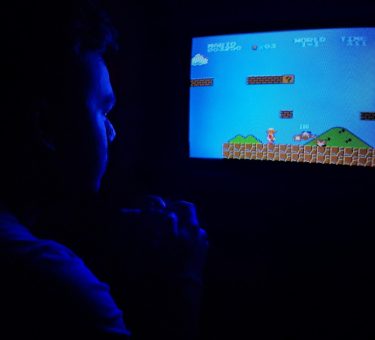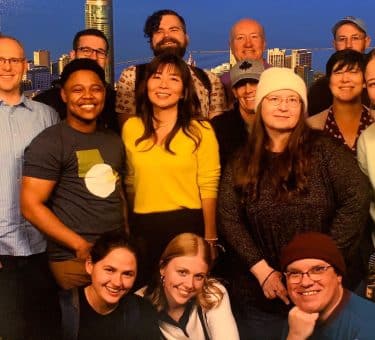Tandem’s product design team works collaboratively to create products for our clients. For today’s Tandem Roundtable, our design managers (Julia and Chris) sat down to discuss how they create opportunities for career growth, cultivate a healthy design culture, and support each other along the way.
Interested in our engineering managers’ perspectives? Check out their roundtable discussion.
What is Tandem’s approach to management?
Julia: It’s not a top-down approach. Designers and developers here have a lot of autonomy, even at the apprentice level. Because we’re learners, we all come from different places in life and have collective knowledge: we can learn from anybody, and we don’t think that managers are smarter than anyone else.
As managers, we have some experience, we’re at a career point where I hope we have good advice, and we are invested in your goals and in helping you further your career. It’s like having a career coach, honestly: we give advice on how to level up, so you don’t have to just hope that career growth happens.
Chris: We lead with trust. And like Julia was saying about autonomy, we give everyone at every level a lot of freedom to explore and to learn through doing, and not just through watching. That’s probably the biggest difference here from other consultancies: even our apprentices are involved at any level. Our managers are here to support you, and not to tell you what to do and how to do it.
How do you balance your management responsibilities with your delivery team/client project responsibilities?
Chris: There’s a lot of context-switching: being a manager, a project lead, and a member of the leadership team are the three levels that I’m oscillating between on any given day. I definitely think it’s important for our team members to know they can make decisions without needed ‘manager approval’ – we’re here to help support them with the frameworks to work through problems without having to be a top-down manager on everything.
Julia: It can be challenging for sure, especially if you’re also leading a project. I think what’s good about being a manager who delivers client work is that you get it. I don’t want to be a manager in my own bubble with no understanding of the challenges of the day-to-day client work. We’re on the client project with everyone else, we understand the struggles, we keep our craft sharp.
Chris: In past jobs I’ve definitely had managers that asked me to do something that sounded possible on paper, but in practice wouldn’t work. The benefit of having managers involved in projects is that we have a shared vocabulary and understanding of what the realities of project work is like, so we can not only offer general advice about best practices, but also advice on some of the things that have helped us when we are in the situations our direct reports face.
How does the leadership team work together at Tandem?
Julia: One of the things I’m so proud of is that we’ve blurred that line between ‘design’ and ‘engineering,’ and every day we feel less and less like two separate teams. We are one team, composed of developers and designers. At the end of the day, we’re building the same products and we work so closely together. As leaders we’re always advocating for more collaboration and less separation between the disciplines.
Chris: The leadership team is united in the fact that we are all very human-centered in our approach to things. We share a common philosophy about what type of culture we want to have and what kind of managers we want to be. Having a shared approach to management makes it easy to connect as a leadership team.
It’s very cool that we are at a tech company that is as invested in our people as we are. We’re all united in our goals: deliver great work to our clients, make sure our people are able to work in an environment where they can contribute, and help all our individual reports feel supported and encouraged to grow.
As leaders, how do you influence Tandem’s workplace culture?
Julia: We each influence it differently, which is good. Chris and I come from two different worlds and the balance of that is beneficial to our team. When I joined the company, Tandem’s design practice took a very fine-arts approach to building software.
Chris: I come from an agency where I was working in digital graphics. Julia comes from a digital products and services background. Because the work we do involves both things, it’s been great to have both of us working to find the meeting point between them. Each of us really appreciates the value of critique.
How do you support your direct reports’ growth?
Julia: Listening. Knowing that not everyone’s goals are the same as yours, and everyone’s personalities are so different. Some people love their current role and want to stay there for a while and learn. Others want to grow and level up on our career path. Both perspectives are cool, and as a manager I need to make sure I listen to each individual’s needs and wants.
Chris: Yeah, I think it’s about knowing what growth looks like to each person. Growth doesn’t always mean a promotion or leading a project. It might mean learning a new skill, or diving deeper into a passion — whether that’s someone who really wants to explore all types of research, or someone who is really fascinated by mobile design. What growth means to each person can be different, so I try to tailor a leadership or mentorship style that helps each person where they want to grow.
Julia: From a design perspective, because we are generalists, we do expect our team members to do ‘all of the things’ in design. And that’s a big ask! So one challenge as a manager is how can we balance your strengths, the things you need to learn, and the things we need you to do? We want you to be happy and learning, and we also need our clients to have great results. That can be a dance sometimes.
Chris: That’s what I tend to focus on in reviews: where do you want to go? For example, if you want to be a senior designer, having our career paths helps because I can highlight the behaviors and skills of the level you are trying to get to. Then together we can look at a senior-level behavior, like being able to estimate in sales meetings, and make a plan for how you can learn that. For me it’s about looking for a model of the thing that my reports want to achieve, in our path or elsewhere, and then figuring out how to get there.
Is there anyone who’s influenced your management style?
Julia: Looking at other companies’ design teams, I know what kind of teams we aspire to be like: whether they’re super cutting-edge, or talented, or have great longevity. I look up to Figma’s design team, InVision’s design team, AirBnB, Spotify, even Apple to some extent. I’m always learning more about what makes their teams produce good work — it’s not an accident.
Our weekly Design Crit, which we’ve refined over time, is literally the brain and the heart of our design team culture. Chris’ work is not perfect the first time. My work is not perfect the first time. And it’s okay! We put work in front of each other and trust each other to give honest and candid feedback to make each other’s work better.
Chris: Some of the best design leaders are people whose crit processes I’ve been inspired by: Jessica Walsh, Natasha Jen, Debbie Millman, there are so many more. These are all people in the design community who have been very generous with their critique and their feedback to other designers, and have also been very transparent about the way their own work has changed over time.
Julia: An example of that ethos is at the beginning of the COVID pandemic, a lot of the UX people on Twitter were like “hey, if anybody wants to do a design crit with me, here’s my google meet link”. They wanted to give back, and not just stand by while others are going through job loss or uncertainty. The act of making sure that it’s a community, and we’re all in it together: that’s the type of team we want.
What do you think is each other’s best quality as a leader?
Chris: I think that Julia is really good at giving constructive and scaled feedback. She can suggest the smallest change that makes the biggest difference, and spot it really quickly.
Julia: Chris is really good at getting people in a conversation to feel comfortable to say what they really think. Some people are so vocally opinionated that you don’t want to disagree with them. It’s really important as a designer to have a safe place to say what you really think, and I think Chris definitely creates that.
What should job candidates know about Tandem?
Julia: You’ll get real experience. You’re not just pixel-pushing behind a screen while somebody else presents your work. You will do real, good, valuable, solid work here. At any level.
Chris: We definitely require initiative. This isn’t the place to work if you just want to take orders and make a screen. This is a place to work if you are going to continue to push yourself.
Do you want to work with Chris and Julia? Check out our current job openings!









